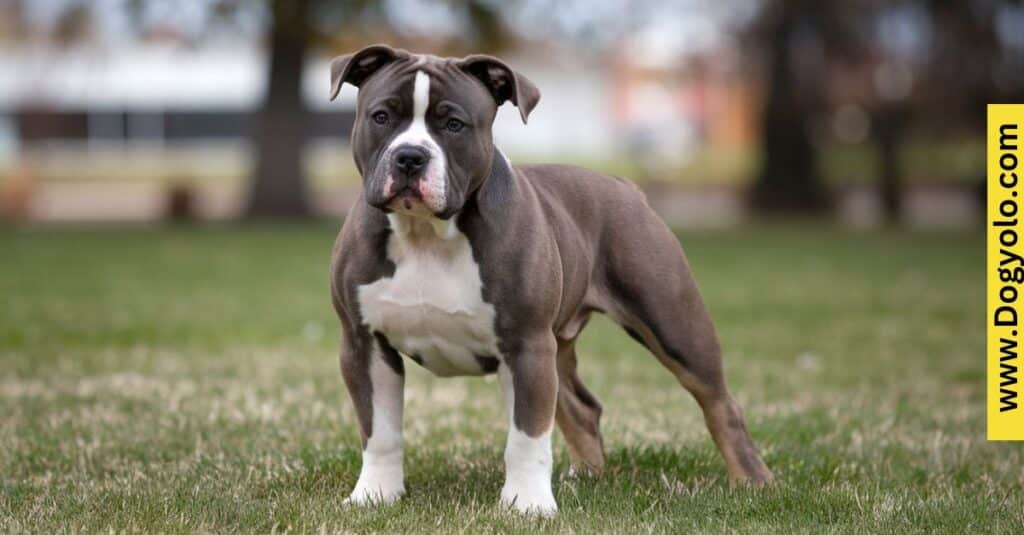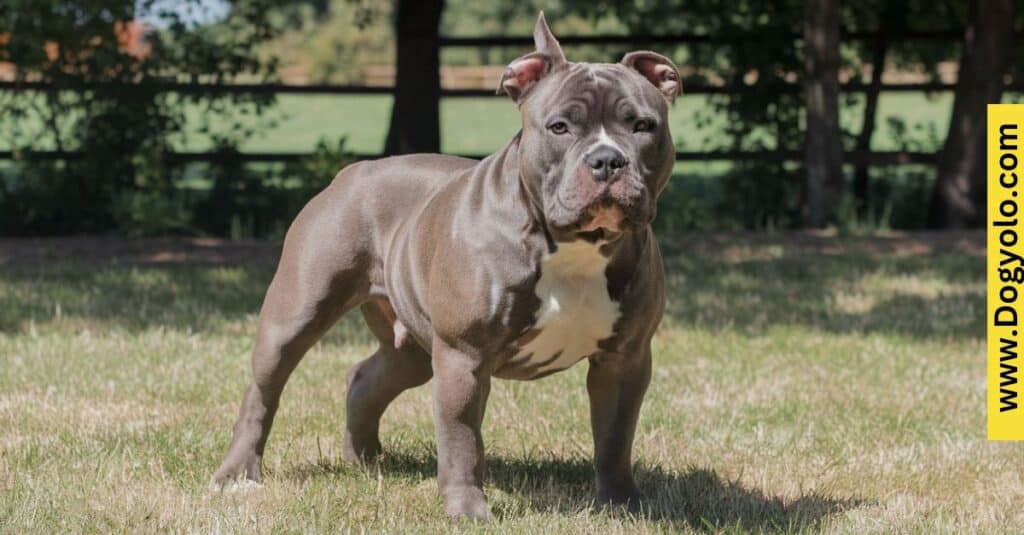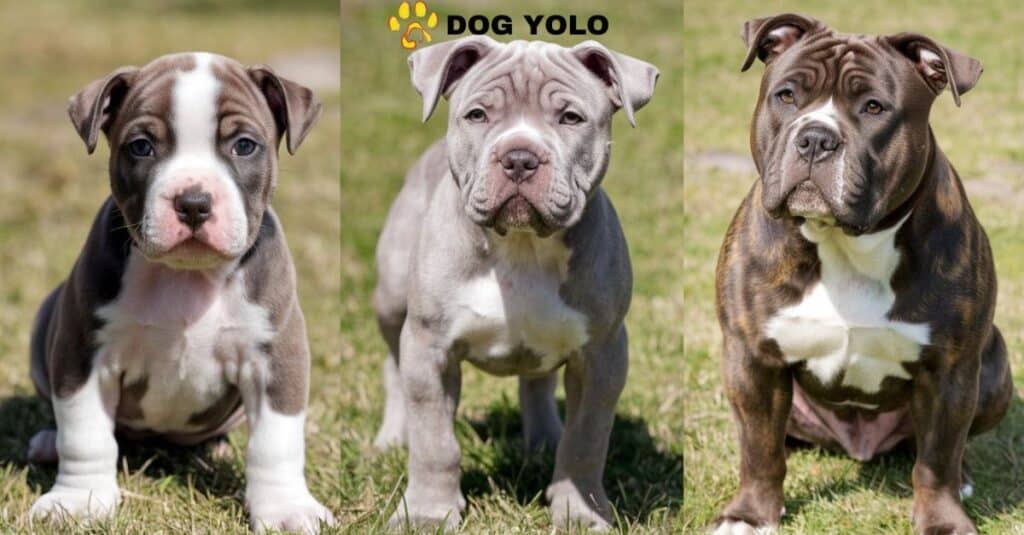The American Bully is a fascinating breed, known for its muscular build, loyal temperament, and diverse size variations. Whether you’re a new owner or a breeder, understanding American Bully growth stages is critical to ensuring your dog develops into a healthy and well-rounded adult.
In this article, we’ll dive deep into the growth milestones, weight charts, and the key factors that influence the development of your American Bully.
Are you worried, your American Bully is not growing as expected?
Keep reading to find out if your Bully is the right size for its age.
Understanding American Bully Growth Stages
The growth stages of an American Bully are like a blueprint to predict how your pup will mature.
Each stage has its own set of characteristics, and knowing what to expect during each phase helps ensure your Bully stays on track.
Newborn to 4 Weeks (Neonatal Stage)

During the first few weeks of life, American Bully puppies are fully dependent on their mother.
In this neonatal stage, growth happens rapidly, but most of it is internal. Pups gain weight and start developing basic physical senses, such as sight and hearing.
- Weight progression: Newborns weigh between 10-16 ounces, doubling in size every week during this period.
- Growth milestones:
- Eyes and ears begin to open around the 10-14 day mark.
- By 4 weeks, they start attempting to stand and move around.
Read more about Cane Corso Great Dane Mix
4-8 Weeks (Weaning Stage)

As your puppy transitions from milk to solid food, it enters the weaning stage. This phase is critical for the development of their bones, muscles, and social behaviors.
- Physical development: Bones become stronger, and the puppy’s skeletal structure begins forming.
- Socialization importance: They start interacting with their littermates and learning basic social skills.
- Nutritional needs: A protein-rich diet is essential to support rapid bone and muscle growth.
8 Weeks to 3 Months (Puppy Stage)

At 8 weeks, your puppy begins to look and act more like a miniature version of an adult Bully. This is also when they leave the breeder and go to their new homes.
- Size increase: Expect a significant jump in both height and weight during this time. Puppies will often gain 2-3 pounds per week.
- Puppy training sessions: Start introducing basic commands, as this is the prime period for learning.
- Health condition: First vaccinations and vet checks are important to ensure your puppy’s health status is optimal.
Fact: By the end of 3 months, American Bullies generally weigh between 20-30 pounds, depending on the size category (more on size variations later).
Read more about 8 Belgian Malinois Colors
3-4 Months (Early Juvenile Stage)

This stage is characterized by tall, lanky growth, where the puppy’s legs and height increase more than their width. At this stage, they can seem awkward but it’s completely normal.
- Growth phases: Expect rapid height growth and a leaner appearance.
- Behavior shaping: Continue socializing your puppy with humans, other dogs, and different environments to build confidence.
4-6 Months (Late Juvenile Stage)

At around 4 months, you’ll notice your Bully becoming more muscular and starting to fill out. Their head and chest begin broadening, a signature look of the breed.
- Weight gain: Your puppy should now weigh between 35-50 pounds.
- Exercise and movement necessity: Regular play and moderate exercise are essential to build muscle tone without overexerting their still-developing bones and joints.
Read more about Cane Corso Mastiff Mix
6-12 Months (Adolescent Stage)

During this stage, your Bully transitions from a puppy into a near-adult. You’ll notice they bulk up significantly, with their head, shoulders, and chest developing the most.
- Weight progression: They should now weigh between 50-80 pounds, depending on their American Bully size categories.
- Sexual maturity: Females may experience their first heat cycle, while males will start developing stronger features and might show more dominant behaviors.
- Physical activity influence: Maintain a consistent routine of moderate exercise to prevent growth issues, but avoid overexercising, as their joints are still maturing.
When Do American Bullies Stop Growing?
While most American Bullies reach their full height between 12-18 months, muscle mass and weight can continue developing until they are around 2-3 years old.
Males tend to grow for a longer period than females, especially in the XL Bully category, where full development might take up to 36 months.
Read more about Meet The Cane Corso Pitbull Mix
Different Sizes of American Bullies
One unique aspect of the American Bully breed is its size variations. From the compact Pocket Bully to the imposing XL Bully, each category has specific height and weight expectations.
Pocket Bully
- Height: Males under 17 inches, females under 16 inches.
- Weight: Typically between 30-60 pounds.
- Known for their compact, muscular build, Pocket Bullies are smaller but carry the same bulk as their larger cousins.
Standard Bully
- Height: Males 17-20 inches, females 16-19 inches.
- Weight: Typically between 65-85 pounds.
- Standard Bullies have balanced proportions, with a sturdy, muscular build that’s neither too bulky nor too lean.
Classic Bully
- Height: Similar to the Standard Bully, but with a lighter frame.
- Weight: Typically between 60-80 pounds.
- Classics are more reminiscent of the American Pit Bull Terrier, with a leaner body but the same defining Bully features.
XL Bully
- Height: Males above 20 inches, females above 19 inches.
- Weight: Typically between 85-130 pounds.
- These are the giants of the American Bully world, with massive heads, broad chests, and a strong muscular frame. Their growth may continue into their third year.
| American Bully Size Categories | Height (inches) | Weight (pounds) |
|---|---|---|
| Pocket Bully | 13-17 | 30-60 |
| Standard Bully | 17-20 | 65-85 |
| Classic Bully | 17-20 | 60-80 |
| XL Bully | 20+ | 85-130 |
Pro Tip: Understanding your Bully’s size category is crucial for monitoring their growth. A Pocket Bully will naturally be smaller than a Standard or XL, so avoid comparing growth rates across categories.
Read more about The Truth Behind Warlock Dobermans
Factors That Impact the Growth Rate of an American Bully

Several factors influence how your American Bully grows, including genetics, diet, physical activity, and overall health.
Genetics
The size and stature of your Bully’s parents provide the best indicator of how large your pup will be. Responsible breeding practices play a huge role in determining a puppy’s potential.
- Genetic principles: Ethical breeders focus on maintaining healthy bloodlines, which helps ensure puppies grow to their full potential without health issues.
Nutrition
Your puppy’s nutritional needs are critical during growth stages. Feeding a high-quality, protein-rich diet supports muscle and bone development.
- Dietary intake: A balanced feeding plan with an appropriate mix of protein, fat, and carbohydrates helps fuel the puppy’s growth.
- Feeding plan:
- 0-4 months: Feed 4 times a day with a focus on puppy-formulated food.
- 4-12 months: Transition to 3 meals a day as their caloric needs change.
- 12+ months: Adult feeding plans with 2 meals per day.
Physical Activity
While exercise is important, balance is key. Too much physical activity can strain their developing bones, while too little can lead to obesity and underdeveloped muscles.
- Exercise routines: Short, playful bursts of energy combined with moderate walks are ideal. Avoid high-impact activities until they’re fully grown.
Health
A variety of developmental problems can occur if an American Bully isn’t growing properly. From genetic conditions to nutrient deficiencies, keeping an eye on their health condition is vital.
- Vet checks: Regular vet visits help track your dog’s growth and ensure they’re not developing conditions like hip dysplasia, joint issues, or allergies that could affect their growth.
Why Is My American Bully’s Head Small?
It’s common for owners to worry if their Bully’s head isn’t growing at the same pace as its body. Don’t fret—Bully head growth often comes later in development, especially in the Standard and XL categories.
- Bully development: Many Bullies “grow into” their heads after the body develops. The head may appear small compared to the broad chest, but it typically catches up during the adolescent and young adult stages.
- When to consult a vet: If by 18 months your Bully’s head is still disproportionately small compared to the body, consult a vet to rule out any health concerns.
Tips to Help Your American Bully Grow Strong and Healthy
- Protein-rich diet: Make sure your Bully gets enough high-quality protein to support muscle growth.
- Regular exercise: Incorporate short walks and play sessions to promote physical fitness without overexerting their growing joints.
- Socialization: Early exposure to other dogs, people, and environments helps shape a confident, well-rounded dog.
- Vet care: Stay on top of vaccinations, deworming, and regular checkups to ensure there are no underlying health issues.
Training sessions: Consistent puppy training sessions should be part of your Bully’s routine to teach them discipline and good behavior.
Common Growth Concerns and How to Address Them
Many owners worry if their American Bully is too small or not growing fast enough. Here are some common issues and how to address them:
- Slow growth: If your Bully is smaller than expected, review their diet and exercise routine. Ensure they’re getting enough protein and consult with your vet about potential developmental problems.
- Underdeveloped muscle tone: Puppies that aren’t active enough may not develop proper muscle tone. Introduce more structured playtime and light walks to build strength naturally.
- Obesity concerns: Overfeeding or lack of exercise can lead to obesity, which places strain on joints and bones. Adjust their diet and activity level to suit their growth stage.
Conclusion
Every American Bully growth stage brings new changes and challenges, but with the right care, you can help your Bully reach its full potential.
From understanding size categories to providing proper nutrition, exercise, and socialization, there are many ways to ensure your Bully grows into a strong, healthy adult.
Remember, while growth charts and weight measurements provide a general guide, each Bully is unique. Consult your vet regularly, keep an eye on their development, and enjoy watching your puppy grow into a majestic, confident dog.
Is your American Bully the right size for its age? Now you know how to make sure they’re growing on track!

Vala John is an experienced blogger at Dog Yolo, where she shares her deep passion for all things canine. With years of expertise in dog care, training, and lifestyle tips, Vala’s writing helps dog lovers build stronger bonds with their furry friends. Her insightful posts make her a trusted voice in the pet community, offering practical advice for dog owners of all levels.







